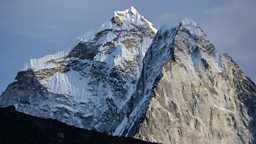Mountain kings
Anthony Pyper, Director
Before I start this article, I have a confession to make... I am incredibly biased. Patagonia is, and always will be one of my favourite places on Earth. A vast, pristine wilderness at the end of the world, and in my opinion one of the true final frontiers of our planet. When I got the call from “Mountain” producer Matthew Wright, asking if I would go back with cinematographer John Shier to attempt to film the pumas of Parque Nacional Torres del Paine for the series, I have to admit I didn’t hesitate for a second.

Once, these remarkable cats were the most widely distributed land mammals in the Western Hemisphere, but after centuries of persecution due to conflict with man, they have been reduced to a fraction of their native range. Today though, this remarkable refuge at the end of the world is one of the last true strongholds of this Mountain King.
That being said, I knew that just catching glimpses of these “Kings of the Andes” was going to be a challenge. Pumas are notoriously hard to film and photograph in the wild – primarily nocturnal, notoriously elusive and skittish with people. It would be a massive challenge to capture the true nature of this apex predator, one that has earned them another name, the “Mountain Lion”…
The other issue was the terrain, each day we would be able to drive into the park by 4x4, but from there on out we would be on our own, tracking the pumas on foot. Even just finding the pumas was going to require a mammoth effort from an incredibly experienced team.
Together with the unprecedented access and permission granted to us by the Chilean National Parks service (CONAF) we were also lucky enough to be working with the some of the most experienced field experts who knew the park like the back of their hand including Christian Munoz Donoso, Cristian Asun and all of the park rangers.
Before even leaving the UK we knew that we wanted to follow the story of a mother raising her cubs in this temperamental mountain world but we had no idea if we would even be able to find them, let alone film her and her cubs. However, nothing could prepare us for what would happen over the next month.
When we got a call over the VHF radio that the mother and her cubs had been spotted, we felt like the flukiest film crew on the planet. No-one ever gets that lucky early on in a shoot!
After hiking to her location, the mother cautiously watched us setting up our equipment over 50m away as her three cubs played in the grass nearby, completely oblivious.
When filming with apex predators, something we always want to do is let them know we are here, so that we don’t take them by surprise, but also want to be almost completely invisible, as we want to film natural behavior – it is such a fine balance, and something we pride ourselves in.
As soon as she realized that we posed no threat whatsoever, she lay back down and John and I knew we had achieved it.
As the weeks went on, we spent many more days with her, filming her raising her cubs in this fickle mountain realm where the weather can turn on you in an instant. People that live here say that you can experience four seasons in a day, and after spending many months filming down here, I can definitely vouch for that! It really does give you a profound sense of respect for the lives the pumas lead and the challenges these pumas face raising their young at the end of the world.
I know I shouldn’t say this, but spending so much time filming with her it is hard not to get attached. Each day we wondered if we would find her and one of the cubs would just be gone.
Towards the end of the shoot, we knew we had a special relationship with the mother, each day as soon as she spotted us and noticed that it was just us she would completely relax, tending to her cubs as though we weren’t there - just part of the landscape but then, in one of the final days she did something truly remarkable.
By this point she felt comfortable enough to be just metres away from us with her cubs, and suddenly her behaviour changed. She spotted a guanaco in the distance, and suddenly went into a stalking posture. She glanced at us and then back to the guanaco and began to stalk, leaving her precious cubs alone with us for almost an hour.
It was a moment of complete trust between wild animal and human being, and something I have never experienced before – one where the trust extends so far as to leave your precious young in the care of a completely different species… It was an absolute privilege to have experienced.
It was an honour to spend a month not only with the remarkable pumas of Torres del Paine, but also with the remarkable people trying to protect this last stronghold of the Mountain King.
If you are one day lucky enough to spend time in this special place as I was, please help to protect it by following the park management’s rules at all times and together we can ensure that the “Mountain Kings” of Torres del Paine are protected for many generations to come.






